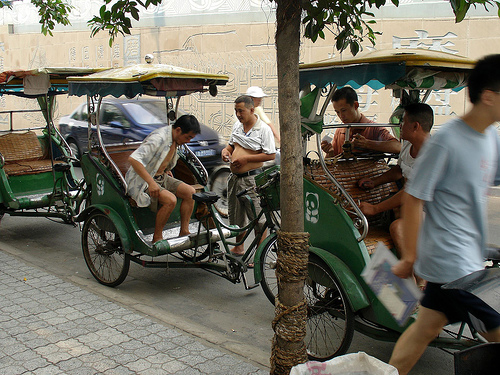the case for the pedicab
So, this is my first post on The City Fix. Recognize parts of it? -UDC
To celebrate World Town Planning Day, the Ontario Planners Institute called on planners, towns and cities to “start planning ahead for a future where the car is a thing of the past.” Although it’s difficult to imagine a post-car city, we only have to look back to recent history to realize that cities are fluid, transforming over time, often based on the dominant form of transport. Because most of our cities emerged during the age of the automobile, it should come as no surprise that most of our cities have been shaped for and by the car. But this wont always be the case. The rising cost of oil and the environmental and human cost of congestion and air pollution is turning the logic of car-dominated cities on its head. As we explore options for a post-car future, it’s instructive to turn to the developing world, where cars still haven’t flooded the streets, and examine one of the most ubiquitous and green-friendly forms of transportation: the pedicab.
In our automobile driven cities, the pedicab occupies the bottom rung of the transportation ladder, frowned upon by both rich and poor alike. Where buses are seen as undisciplined nuisances with which cars must begrudgingly share the road, the pedicab is viewed as a backwards mutant not even deserving of the asphalt. Even pollution spewing autorickshaws and tuktuks are preferred to the pedicab. Some even refer to pedicabs as “road roaches” because they scamper and scatter in and out of traffic like cockroaches in the light. But as far as green cred goes, all other modes of transport pale in comparison to these human powered vehicles. Pedicabs generate no emissions and produce no waste, unlike cars and buses, with their heavy metals from used batteries that leech into the soil.
As far as low barriers to entry, the pedicab business is one the Bottom of the Pyramid folks at Nextbillion would love. You could literally buy hundreds of pedicabs for the price of one bus. Plus all building materials can be sourced locally, so there’s no need to import spark plugs or oil filters or engines. What’s more, there’s no need to buy oil that supports oppressive petrocracies. And the technology is so simple that self-repair is the rule rather than the exception. Bike infrastructure can help power local economies, as it has in Portland, Oregon, where an entire industry revolving around bicycling has emerged.
Pedicabs are unsafe only when they mix with other vehicles, affording little protection to the driver and the riders. And perhaps that’s the design challenge that our cities and city planners could solve. It is clear that our streets were not designed for pedicabs which must vie for a slice of the road with fast moving buses, trucks and SUVs. But what if cities built a city-wide green network anchored on shared roads for bikes, pedicabs, and pedestrians? Cities could set apart secondary and tertiary roads and designate them as green ways. They could redesign the road right-of-way to be friendlier to pedestrians, bikes and pedicabs. We could create a modified version of the Woonerf street to build alternative transport infrastructure that’s friendly to pedicabs.
The most bike friendly cities in the world are leading the way, engineering their streets to encourage biking. But these western cities are building bike infrastructure only for single riders. Perhaps the global south can lead the way with public transport built on human-powered service. The pedicab is the perfect place to start!
(Cross posted from: The City Fix)


3 comments:
Assuming you could find the space there are few places where the economics would work out as the basic productivity of such a pedicab driver would be so low as to earn him a place in the formal economy. Keeping him in the informal economy drags his ability to become more productive , ironically.
peter,
your comment confuses me. Are you saying building the infra for pedicabs will require bringing the pedicab drivers into the formal economy -which would be detrimental to them economically?
UDC
Sorry the prose is well ... not very clear! Not enough punctuation and poorly constructed sentences don't communicate what I mean.
I make the following points.
In general being in the informal economy is a drag in total macroeconomics and to the citizen in particular in the long run.
In the city of MetroManila , there are very few places (in fact I can't really think of any) that this type of transportation would make it high paying enough for a pedicab driver to earn enough and stay within the formal economy.
As a solution to mass public tranport, this type of transportation is very limited at best.
Post a Comment